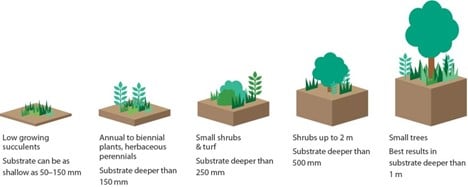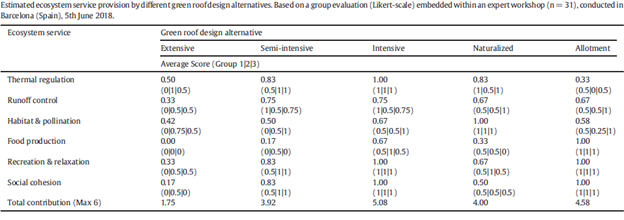There is a green roof for every use, be it a new family house, large hospital, garage, storage facility, a delicate renovation – even a shed or a doghouse! To decide on the appropriate green roof to use for any project, it is of uttermost importance to do your research to ensure the best performance and/or desired appearance.
Green roofs, the vegetated coverage of building rooftops, are increasing in popularity due to their various benefits. They provide ecosystem services like stormwater management, thermal regulation, enhance the local provision of food and provide wildlife habitats, but also less tangible non-material and cultural services like relaxation and social integration. Architects and planners have embraced rooftop gardens as aesthetically intriguing as well as highly functional spaces. Municipalities are actively promoting green roofs installation through policy instruments like construction regulations and economic incentives, while academic study of the subject has grown exponentially. There are three standard industry typologies; extensive, semi-intensive, and intensive, mostly differentiated by substrate depth, associated vegetative capacity and maintenance requirements. Additionally, two specialized categories; naturalized and allotment roofs are appearing as distinct typologies (1).

Source: http://www.growinggreenguide.org/technical-guide/design-and-planning/plant-selection/green-roofs/
Extensive green roofs
Extensive roofs are thin, lightweight roof systems that typically have a planting media measuring 6 to 15 cm deep. An extensive green roof weighs about 60 to 150 kg/m2. Extensive green roofs can typically only accommodate a small selection of drought-tolerant plants with shallow root systems. Mosses, sedums, succulents, perennial herbs and low-growing grasses are common choices for extensive roofs. Due to that, extensive roofs have low maintenance needs and they don’t require irrigation except during a prolonged heat wave. They are also the least costly and especially useful in renovation project where the weight of the roof is limited (1, 2).
Semi-intensive green roofs
Semi intensive green roofs, as their name states, are a combination of the aforementioned two types. They have a thinner planting media than an intensive roof, but thicker than an extensive one, and the whole system ranges from 15 to 25 cm. This is enough to grow grasses, herbs, aromatics, bulbs, creepers and small shrubs. The weight of a semi intensive roof is about 120 to 200 kg/m2 (1, 2).
Intensive green roofs
Thicker green roofs are known as intensive roofs and their growing media ranges in thickness from 25 cm to 100 cm. An intensive roof weighs more than 180 kg/m2 and up to 500 kg/m2.
Intensive green roofs can support the growth of a wide range of plants, including shrubs and small trees. This results in a higher demand for upkeep as well as regular irrigation. Intensive roofs are also generally the most expensive (1, 2).
Naturalized roofs
Naturalized roofs are typically planted with endemic species emulating natural habitats like meadows, for example. They also generate the highest potential ecosystem service provision levels. The substrate depth is similar to that of semi-intensive roofs – ranging from 15 to 30 cm, and so is the cost. They weigh between 200 and 450 kg/m2. (1) Due to the fact they use local plant species, they can have the most effect on the local wildlife, providing food and shelter for various insects, birds and even urban bats – thus having an important positive effect on urban biodiversity (3).
Allotment
Allotment roofs are especially designed for rooftop agriculture. They are used to grow garden vegetables, aromatic and medicinal plants and even fruit trees, which means they need a lot of maintenance, irrigation and regular upkeep. The substrate needs to be at least 30 cm deep and they usually have a weight of over 450 kg/m2, which makes them the heaviest of the lot (1).
How to decide on the right green roof for your project?
The type you should use depends on your goals, project type and budget. The most common factors generally fall into the following categories: thermal regulation, water management, habitat and pollination, food production, recreation and relaxation, social impact (1).
When dealing with a roof that needs to be slim, affordable, lightweight, easy to install and low-maintenance, extensive green roofs will be the best choice. However, if your goals is maximum thermal regulation, an intensive green roof is the most effective due to its thickness. For water management, it depends on the material used, but generally, semi-intensive and intensive green roofs have the highest retention properties, as well as being the best in terms of recreation, relaxation and social impact. Plant usage can also influence the water management performance of a green roof. If your goal is to grow vegetables, the allotment green roof is the correct choice to ensure enough substrate. Naturalised roofs are the most effective when your goal is to use green roofs as a means of looking after the environment and providing a habitat for both plants and animals – this can even be included in your green business strategy.

Source: J. Langemeyer, D. Wedgwood, T. McPhearson, F. Baró, A. L. Madsen, D. N. Barton, 2019. Creating urban green infrastructure where it is needed – A spatial ecosystem service-based decision analysis of green roofs in Barcelona
Plant selection
If water management is the main goal of installing a green roof, plants that soak up water and remove contaminants during storm events should be explored. Herbaceous or shrubby species, which use more water than succulent species, will be more effective plant choices (4).
If aesthetics are important, then select plant species that will provide interest throughout the year, and consider both foliage and flowers (4).
In areas with drought, plants that come from ecosystems with shallow soils, such as rock outcrops, have been shown to both survive extended dry periods and make use of the high water available after rainfall and dry out the growing substrate. Successful species have also been shown to re-sprout after droughts, offering an ‘insurance policy’ if conditions are particularly harsh (4).
Therefore, with enough research, any roof can become a green roof! To learn more about performance in various climates, visit one of our previous blogs: https://blog.urbanscape-architecture.com/different-green-roofs-for-different-local-need-and-environments
- Johannes Langemeyer, DiegoWedgwood, Timon McPhearson, Francesc Baró, Anders L. Madsen, David N. Barton, 2019. Creating urban green infrastructure where it is needed – A spatial ecosystem service-based decision analysis of green roofs in Barcelona. https://doi.org/10.1016/j.scitotenv.2019.135487
- The European Portal for Energy Efficiency in Buildings - https://www.buildup.eu/en/learn/ask-the-experts/which-are-different-types-green-roofs (31.1.2021)
- https://blog.urbanscape-architecture.com/a-new-home-green-roofs-facilitating-habitat-restoration
- http://www.growinggreenguide.org/technical-guide/design-and-planning/plant-selection/green-roofs


